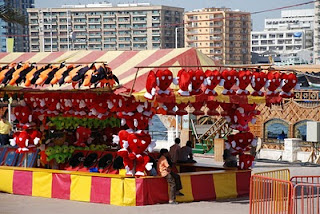All roads are decorated with speed bumps, or humps in local parlance, that are intended to slow the traffic before round-abouts or U-turn opportunities.
There are very few legal left turns on UAE roads. Instead, you drive past your intended street and find the first opportunity to make a 180 and go back for a right turn. In heavy traffic, this leads to incredible jams of cars turning around at any break in the median, often two abreast.

This picture shows the view of the mountains as we drove on highway 88 toward Dibba. It was Friday morning, the Sabbath so to speak, so there was not much traffic at all.
For all the traffic in the cities of Dubai and Abu Dhabi -- which can jam up like K Street in Washington at the drop of a hat -- there are also wide open spaces. Dubai already has a beltway road, six lanes in each direction, and it's "heavy traffic" if you see another car on it. As we drove out on Friday morning, there were only the large power line pylons marching alongside the road.

Motorways in the Emirates are well marked with speed limits, merging traffic signs, information about forthcoming intersections, and direction to major towns. Important tourist sites identified on brown signs with white letters, just like in the U.S.
Smaller two lane roads wind through towns and villages, with many small shops and services lining the highway with their colorful, brightly lit signs. There are lots of grocers, telephone salesmen, air conditioning sellers, rug merchants, and fabric sellers. Given the number of fabric shops, I conclude that people buy fabrics and take them to tailors who make the clothes. There are few shops that specialize in women's or men's ready-made clothing. And, while you don't see many hair salons for women, but almost every block has a barbershop, and inside is a man getting a shave. This seems to be true at almost any hour of the day or evening.








 the self-declared "world's only seven-star hotel" -- the Burj Al-Arab. The shape of the building is like that of an Arab ship's sail, and it is said that some Middle East royalty keep a suite here at all times, just in case they decide to come by on short notice. Of course, it stands on its own man-made island. I understand you have to make a reservation about three days in advance just to visit for a coffee or lunch. If you wonder why I am not staying here, the smallest suite is about 1,820 sq ft and the per night cost begins at $2,000. The larger suites go up to 8400 sq ft and cost $28,000 per night. Not within my allowance.
the self-declared "world's only seven-star hotel" -- the Burj Al-Arab. The shape of the building is like that of an Arab ship's sail, and it is said that some Middle East royalty keep a suite here at all times, just in case they decide to come by on short notice. Of course, it stands on its own man-made island. I understand you have to make a reservation about three days in advance just to visit for a coffee or lunch. If you wonder why I am not staying here, the smallest suite is about 1,820 sq ft and the per night cost begins at $2,000. The larger suites go up to 8400 sq ft and cost $28,000 per night. Not within my allowance.






